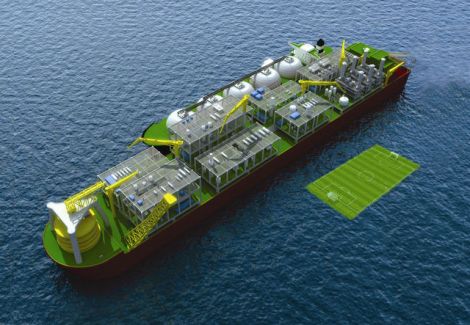Pretty soon there’s going to be a new world’s biggest ship. Cool, right? It’s probably going to sail the seas, laden with toys for children and cute animals, and bring joy to every dock. Like a reverse pirate ship, sent on missions to cheer up any city that needs it, overflowing with wonderful goodies and puppies and tons of mylar balloons with smiley faces on them. Right? That’s probably what it’s going to carry.
Shell will forge the hull of a floating [liquefied natural gas] plant in South Korea by year-end that will be the world’s largest vessel, weighing six times the biggest aircraft carrier, a Nimitz-class warship. Some 5,000 workers will build the factory to produce LNG off Australia’s northwest coast in a $13 billion project that also will shield Shell from escalating costs it would have to pay at the country’s onshore plants.
Rivals from Malaysia’s Petroliam Nasional Bhd. to GDF Suez SA of France likewise want to turn gas into liquid at sea, where many of the largest finds were made in the last decade. It’s a generational change for a land-based industry that started about 50 years ago in Algeria, where Shell provided technology for Camel, the first commercial LNG plant. Today those facilities typically cost at least $20 billion to build.
“We remove the need for the pipeline and use about 50 percent of the raw materials for an equivalent onshore plant,” said Neil Gilmour, Shell’s FLNG general manager. He’s overseeing construction of the world’s first floating LNG vessel, which will be as long as the Empire State Building, for use by the Prelude venture partners.

World’s biggest ship sails past world’s worst soccer field. (Image courtesy of Royal Dutch Shell Plc/Bloomberg.)
Oh, so it’s going to be a giant gas refinery. That’s cool too, I guess.
Prelude will produce about 3.6 million metric tons of LNG and 1.3 million tons of gas condensate a year. It will cost between $10.8 billion and $12.6 billion, based on figures Shell provided when it approved the project last year. Shell estimated the cost at about $3 billion to $3.5 billion per million tons of LNG a year.
So if a million metric tons of LNG is 52 trillion British thermal units of energy and LNG generates about 120 pounds of CO2 per million Btus [PDF, see Figure 4] when combusted, that’s … 22 billion pounds of CO2. Per year. Just from the LNG this megaship produces.
Maybe a more useful “world’s biggest ship” would be an ark.



